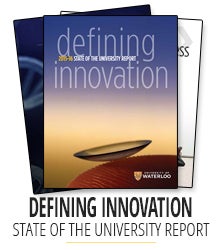
Defining Innovation: Find out how Waterloo is reshaping higher ed
New report shows how University of Waterloo is enriching its entrepreneurial culture and investing in new discoveries

New report shows how University of Waterloo is enriching its entrepreneurial culture and investing in new discoveries
By Staff Marketing and Strategic CommunicationsAt the University of Waterloo, innovation is in our DNA. Building one of the world’s top innovation universities takes talent, curiosity, drive, passion and a single-minded focus on creating real-world change.
You’ll find the latest on how the University of Waterloo continues to redefine higher education in Defining Innovation, our 2015-16 State of the University Report.
With dynamic, shareable content, learn how we are taking our world-leading approach to co-operative education and creating something even better — with more opportunities for more students to gain real-world, relevant experience.
 Find out how we’re enriching our entrepreneurial culture by investing in new discovery and incubation space, and growing the support and mentorship students need to launch the next billion-dollar venture. And join us as we explore frontier research in areas like quantum information, sustainable energy and global security.
Find out how we’re enriching our entrepreneurial culture by investing in new discovery and incubation space, and growing the support and mentorship students need to launch the next billion-dollar venture. And join us as we explore frontier research in areas like quantum information, sustainable energy and global security.
We’re proud to share our story in Defining Innovation, Waterloo’s 2015-2016 State of the University Report.
In the coming months, watch for more about how Waterloo is Defining Innovation, by following the hashtag, #UWaterlooInnovation.

Read more
From 74 engineering students in 1957 to 198,000 alumni six decades later

Read more
Special issue of Waterloo Magazine celebrates women who lead, and explores equity in education and the workplace

Read more
New building will have some of the best research facilities in the world and support students as they design, build and test their ideas
The University of Waterloo acknowledges that much of our work takes place on the traditional territory of the Neutral, Anishinaabeg, and Haudenosaunee peoples. Our main campus is situated on the Haldimand Tract, the land granted to the Six Nations that includes six miles on each side of the Grand River. Our active work toward reconciliation takes place across our campuses through research, learning, teaching, and community building, and is co-ordinated within the Office of Indigenous Relations.